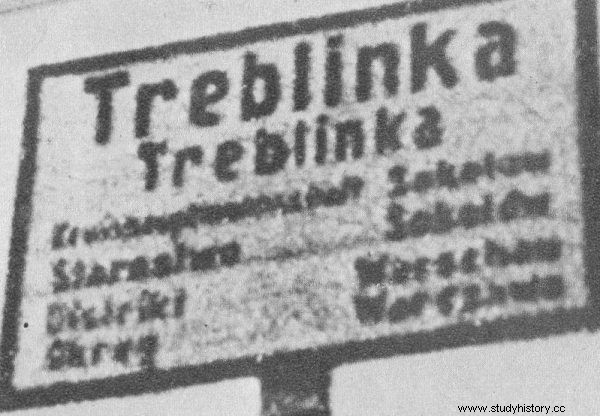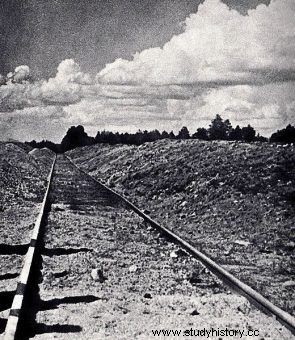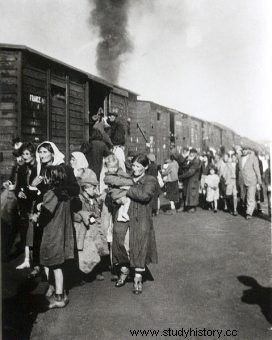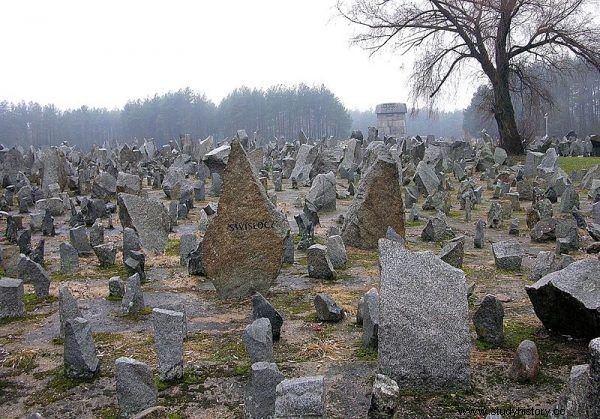To survive hell - this term fits the personal stories of people who managed to survive the prison in Treblinka. We present some written stories of those who fled from death or witnessed this brutal machine of bestiality.
In 1942, Heinrich Himmler decided to liquidate the Warsaw ghetto. This decision made the Germans develop the construction of a new extermination camp; the site was chosen at the intersection of the roads connecting Warsaw, Białystok and the Radom District. It fell on Treblinka.
Memories of Richard Glazar
Richard Glazar (owner:Richard Goldschmid), Czech Jew and engineer. A prisoner of Treblinka, a witness at the trials of Nazi criminals.
The train stopped and then slowly, almost at a walking pace, turned into the forest. On the right was a clearing that turned into flat ground that stretched all the way to the horizon. There were cows grazing, and a shepherd boy stood next to them, barefoot - like one out of an old fairy tale - and stared at the train from a distance. Someone called out to him through the open window. From this distance, and in Czech, the boy could not understand anything. He heard only a call, saw the inquiring glances of people behind the glass. He grabbed his neck with both hands, made a movement as if he wanted to choke himself, his eyes widened, his tongue stuck out - how boys do such antics. He froze for a moment, then turned and ran back to the cows (...).
Ramp, behind it a wooden barrack, people on the ramp in high boots, but dressed in civilian clothes (...). It all looks like a small ignition switch in the Wild West, followed by a large farm with a tall hedge. A nice green hedge, it will be a large farm with lots of cattle (…).
Oh, you have to run here, you can't walk. In a great square where you look, a pile of clothes, shoes; all sorts of things are piling up - and human hustle and bustle everywhere, like in a barracks (…).
Schlauch - a narrow passage between the barbed wire resembles a lock through which wild animals are allowed to enter the canteen. But this passage is longer, meanders and you can't see anything from the inside or outside (...).

Information board
Those from the Warsaw ghetto, from Grodno and from other towns in the East are half alive after being driven into cattle cars or on the way. Most of them are crammed into a corridor with "shower cubicles" on both sides. SS men and Ukrainian guards with beatings force the rest inside. The order is given:Ivan - water! - and the Ukrainian wachman starts the engines. Showers spray exhaust fumes instead of water. The final product of Treblinka will be ready in about twenty minutes. And yet successive slaves reach for this naked, massed gray and lilac-colored fabric. Some pull out the bodies through the openings in the outer walls of the gas chambers, while other specialists pull out the golden teeth of the dead. Who is a dentist, dental technician, or who knows gold - aside, get dressed, you will work here ... Others put them in mass graves. Then follow the final procedures, "powdered" with lime and covered with sandy soil of Treblinka - this is what a continuously working dredger does. It was her growl that I heard on the first day (...) .
Memories of Jerzy Rajgrodzki
Jerzy Rajgrodzki, prisoner, member of the camp orchestra.
On the assembly square, between the barracks, there was a well and a field kitchen. We got dinner. Soup with unpeeled potatoes. Food was taken from packages. After sunset, roll call. From the entire crew, numbering several hundred people, the Germans chose probably about 30 who were destined to die. Then one of the chosen ones, a stocky, medium height, jumped out and hit the SS man in the back with a knife. As they said later, the SS man died after two weeks. The stocky hero was killed immediately. A terrible scene began. They surrounded us on all sides and fired into the crowd, hitting us with hooks and butts. Whoever was weaker and fell has been trampled underfoot. The crowd swayed it back and forth (…). There were many dead bodies in the middle of the square. Ten were selected again. They were placed in the middle of the courtyard and shot in the back in front of everyone (…). I began to realize where I was, and like everyone else, I thought it was last night. It was the first day of my stay in Treblinka (...).

A railway track leading to the gravel pits at which the Treblinka I labor camp was located. From this track, in June 1942, a branch was built leading to the Treblinka II extermination camp
In October, when I was carrying the dead bodies from the new chambers, one kapo brought a violin and asked who could play. I reported to him. He fired me from my job carrying corpses and told me to play in the square, next to the corpses. After a while, an oberkapo passed by and took me to the kitchen with him. I played a few songs that he mentioned to me. From that day on, I started working as a Kartofelscheiler (…).
I have worked several times with the disposal of corpses. They were intertwined, they were sweaty and the layer was about 1.5 meters high. The walls were tiled. The area of such a chamber could be 30-40 m2. The floor was cement. There was a shower-like installation on the ceiling. The entrance to the gas chambers from the side of Himmelstrasse was spectacular. There was a colonnade. The whole thing is similar to the entrance to the synagogue. In the middle, above the entrance, there was a Zionist star against the background of the portico (...).
Women were destined for different kapos. They were young, pretty young ladies with intelligent appearance. It so happened that one was going with one and always the same. Heller had one black one, it was quite large. He was tall too. They sat in their corner at the table and made love. It was a sad love of people sentenced to death sooner or later (...).
Memories of Jerzy Królikowski
Jerzy Królikowski, road and bridge construction engineer, delegated to work as a works manager in Małkinia, near the Treblinka camp.
In the spring of 1942, we completed the reconstruction of one of the spans of the bridge for the railway track from Małkinia to Warsaw and we had to move to the Siedlce-Małkinia line (...). So we had to leave the village of Prostyń and move to the village of Treblinka, the closest to the new construction site. The village was located not too far from the tracks of the Treblinka station, so our quarters were only 400 meters away from the place where the unfortunate convicts had last been in the area not yet surrounded by camp wire. During this period, however, nothing indicated that this station would be a place of such terrible experiences for hundreds of thousands of people. As usual, in the spring, nature came to life, the Bug river wicker and orchards of Treblinka were covered with fresh greenery, and whole choirs of nightingales sang among it (...).

Jews from the Siedlce ghetto getting on the train to Treblinka
On July 23, 1942 (such dates are never forgotten), a strange train passed over the bridge on the Małkinia - Siedlce line, next to which we were working. It consisted of covered freight cars, the windows of which were barbed with barbed wire. The people's haggard, pale faces could be seen through the dense bars. Soon three more such trains crossed the bridge on the same day. They were all escorted by individuals armed with hand machine guns, uniformed according to German fashion, but in a different way than the army or the police . The escorts sat in the brake booths, and the more zealous stood on the steps or even on the roofs of the carriages (...).
From such a few direct observations I remember, probably forever, terrible memories, which, despite the passage of 20 years, I can still describe in detail today. One of the hot days of late July or early August 1942, from a transport passing by me on the bridge, I heard similar voices crying for water to a groan. The people crowded into the carriages and those who had ridden in them had probably been dying of thirst for several hours already. Another time, in the window of a car passing by me, I noticed two handsome young women, their mouths pink while holding mirrors in their hands. When I thought that these two beings would be in the gas chamber in a few hours, the sight struck me as simply macabre, and the uncertainty of human life in these terrible times was particularly vivid (...).
For many prisoners, the Treblinka station was the last station on their way of life. There were escapes, but the fugitives rarely avoided the rifle bullets of the escorts. Moreover, drunk escorts often played with prisoners, suggesting them to escape after taking tribute in money or valuables, and then shooting at the escaped. So, at times, railway platforms were put at the station, on which the corpses were loaded and returned to the camp. The convoys had to be calculated from the number of escorts:alive or dead (...).
Memories of Jankiel Wiernik
Jankiel Wiernik, a Polish Jew rescued from the Treblinka camp, one of the organizers of the armed rebellion in the camp in August 1943.
We were eating very badly (…). They were reluctantly separated from old stocks. We ate moldy bread and washed it down with water. Typhus arose from hunger. The sick person did not need treatment in bed. A bullet in the neck. Life is over (…).
An attempt to burn dead bodies has started but it has failed . It turned out that women burn better than men. So the women were taken for kindling. Since it was hard work, it started with a competition between the groups - which would sleep more. Charts were made and the number of burns was recorded every day. Gasoline was poured over the corpses and burned in this way. It was too expensive and the result was poor. The men hardly wanted to burn. When the plane was spotted in the air, the work stopped, and the drawn corpses were covered with Christmas trees so that they would not be noticed during the flight . It was a terrible sight. The most horrible human eyes have ever seen. When pregnant women were burned, the abdomen would burst, and the baby would get out and so on in the mother's womb. It did not make any impression on the robbers (...).

Monument on the site of the former German Nazi death camp in Treblinka.
I am not a young man, I have seen a lot in my life, but Lucifer himself is not able to create a greater hell. Can anyone imagine a grate of this length (ed. We're talking about a prepared grate made of railroad tracks, about 150 meters long), with 3000 corpses of just living people on it? (…)
The robbers twisted their mouths with satisfaction and kept their victims tensed for a long time. When some women with children were killed, others were standing and waiting their line. More than once the torturers would snatch a crying child from their mother's hands and throw them alive into the fire. They also laughed, exhorted their mothers to heroically leap into the fire for their children, and mocked their cowardice. I experienced thousands of such terrible, terrifying images (...).
Memories of Samuel Rajzman
Samuel Rajzman, Polish Jew, survivor of the Treblinka death camp
(...) death threatened for the slightest offense. For a piece of bread not from the camp bakery (...), for keeping 5 groszy or a wedding ring, the last memento of his wife, in a pocket, there was a risk of death. The types of death varied. Torment with knuts while constantly pouring cold water on the victim. Hanging on the gallows by the legs. Torn by dogs - Untersturmfürer Franz's favorite game. The shooting was the gentlest death desired by all.
(...) Camp commander Hauptsturmführer Stengl, former owner of a shop in Vienna, had a passion for precious stones and pearls (...). On his chest was the Cross of Merit. He never did dirty work personally, he had enough helpers for this, but he could never get enough of the sight of tens of thousands of people arriving, and he did not pass any transport. On the day when the shipments did not arrive, he became melancholy.
The deputy commander, Untersturmführer Kurt Franz (...) liked to walk around the square with Barry the dog, an animal of huge height and no less wild than his master. Franz demonstrated the amazing results of his training. The dog attacked the target and torn off a piece of the body. Franz checked if the bite was in the right place, and if the dog missed, the experiment would start all over again (...).
A train arrives from Warsaw, an elderly gentleman gets off and meets in Hauptsturmführer his old friend with whom he met at some international conference abroad before the war. The Hauptsturmführer walks with him to the office (an exceptional case for a Jew to cross these thresholds), and in about an hour you can see this gentleman, accompanied by the Hauptsturmführer, leave the camp. Shots are heard in the courtyard. Workers bring a dead body. The Hauptsturmführer wanted his friend to spare a bath, and shot him with his own hand in the back of the head.
